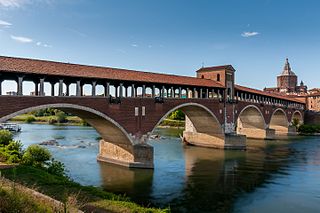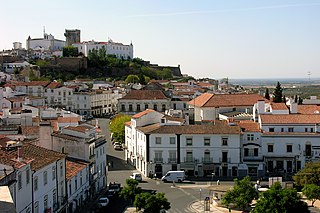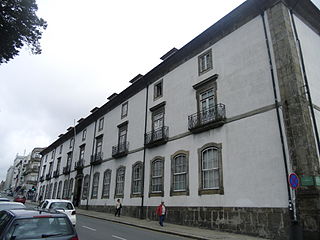
Pavia is a town and comune of south-western Lombardy, in Northern Italy, 35 kilometres south of Milan on the lower Ticino near its confluence with the Po. It has a population of c. 73,086.

Mazzorbo is one of various islands in the northern part of the Lagoon of Venice. Like the other islands in this part of the lagoon, it was the site of one of the earliest settlements in the lagoon which predated the development of Venice. However, these islands then declined and were eventually abandoned. In the 1980s the architect Giancarlo De Carlo built a brightly coloured residential neighbourhood to help to repopulate Mazzorbo. In 2019 its population was 256. It is linked to Burano by a wooden bridge. It was once an important trading centre but is now known for its vineyards and orchards. Its main attraction is the fourteenth century church of Santa Caterina.

Catherine of Bologna [Caterina de' Vigri] was an Italian Poor Clare, writer, teacher, mystic, artist, and saint. The patron saint of artists and against temptations, Catherine de' Vigri was venerated for nearly three centuries in her native Bologna before being formally canonized in 1712 by Pope Clement XI. Her feast day is 9 March.

Patrimonio Nacional is a Spanish autonomous agency, under the jurisdiction of the Ministry of the Presidency, Justice and Relations with the Cortes, that administers the sites owned by the Spanish State and used by the Monarch and the Spanish Royal Family as residences and for State Ceremonies. The Patrimonio Nacional includes palaces, gardens, monasteries and convents, called the Royal sites. When not in official use, the Royal sites are open to the public. It also manages the official and holiday residences of the Prime Minister.

The Church and Convent of the Girolamini or Gerolamini is a church and ecclesiastical complex in Naples, Italy. It is located directly across from the Cathedral of Naples on via Duomo. The facade is across the homonymous piazza and street from Santa Maria della Colonna. It is one block west of Via Duomo.

San Marco is a Catholic religious complex in Florence, Italy. It comprises a church and a convent. The convent, which is now the Museo Nazionale di San Marco, has three claims to fame. During the 15th century it was home to two famous Dominicans, the painter Fra Angelico and the preacher Girolamo Savonarola. The church houses the relics of St Antoninus of Florence and the tomb of Pico Della Mirandola, a Renaissance philosopher known as the "Father of Humanism."

Sister Plautilla Nelli (1524–1588) was a self-taught nun-artist and the first ever known female Renaissance painter of Florence. She was a nun of the Dominican convent of St. Catherine of Siena located in Piazza San Marco, Florence, and was heavily influenced by the teachings of Savonarola and by the artwork of Fra Bartolomeo.

The Biblioteca Nacional de Portugal is the Portuguese national library.

The Museo internazionale e biblioteca della musica is a music museum and music library in the Palazzo Aldini Sanguinetti, in the historic center of Bologna, Italy.

Estremoz is a municipality in Portugal. The population in 2011 was 14,318, in an area of 513.80 km2. The city Estremoz itself had a population of 7,682 in 2001. It is located in the Alentejo region.

The Municipal Library of Porto is a library located in the civil parish of Bonfim, municipality of Porto in the Portuguese district of the same name.

The Biblioteca Comunale degli Intronati is the public library located at Via della Sapienza #3 of the comune of Siena, in Tuscany, Italy.

The Biblioteca Queriniana is a public library with a rich collection of ancient manuscripts, located on Via Giuseppe Mazzini in Brescia, region of Lombardy, Italy. The library was founded in 1747 and owes the nucleus of its collection to Cardinal Angelo Maria Querini (1680–1755).
The Biblioteca Laudense is the main public library located on Via Solferino #72, in the town of Lodi, in the region of Lombardy, Italy. The library is in the Palazzo San Filippo, once housing the convent and chapel of the Oratorians. It now houses the library and a Civic Museum of Lodi.

The Convent of Santo António da Cidade is a former-convent and public library in the civil parish of Bonfim, in the municipality of Porto, in the Portuguese district of the same name.
The Biblioteca Passerini-Landi is the main library of the comune of Piacenza, region of Emilia-Romagna, Italy.
The Biblioteca Guarneriana is a public library founded by the mid-15th century and located in two buildings along the Via Roma in San Daniele, Udine, region of Friuli, Italy.
Francesco Del Furia was an Italian scholar and librarian of the Biblioteca Marucelliana in Florence.

The Convent of Santa Maria in Aracoeli, also called Convent of Aracoeli and formerly known as Convent of Santa Maria in Capitolio, was a historic monastic complex of medieval origin in Rome, Italy, which first belonged to the Order of Saint Benedict and then to the Franciscans.
San Secondo is a Roman Catholic church and monastery located on Via Tifernate #6 just west of the medieval walls of Gubbio, region of Umbria, in Italy. The school of canons once associated with this church educated the patron saint of Gubbio, Saint Ubaldo (1085-1160).















